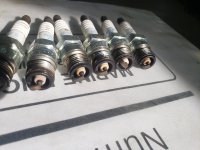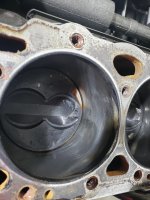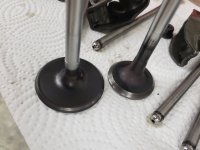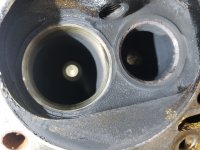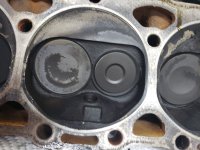So , here's the deal , I have a merc 4.3 with 4bbl , fresh rebuild last year .030 over , .039 gasket , deck height is stock , so would of been 0.025 with stock pistons but now I had rebuilder pistons in it that I had realized after the fact had a compression distance of 1.548 as opposed to 1.56 therefore deck height is 0.037, the pistons in question are speed pro H345DCP flat tops with 4 reliefs -6.8cc , non vortec heads , my calc CR with 64cc Heads is now at 9.39:1 , stock is 9.3:1
this leads to a quench distance of .076 ,yeah I know not good right , but did the stock .064 have any quench effect is the real question I guess? Possibly the flat top may even help with that vs dish top???
Long story short I decided to run like that last year , and it is running quite strong , Larson SEI180 , 5 in boat pulls out two adult skiers on one ski no problem and does over 50mph. (prop quicksilver High5 21*)
I never heard pinging and ran it hard all summer , so far so good , what may be pertinent to know also is I only run 91 octane and have a 142 degree thermostat.
I now have vortec heads to put on it with a performer 2114 manifold , just because why not, and am now debating this quench thing again , will the vortec heads provide more quench effect with flat tops?? If I am not worse off than with the non vortec head then I think I will leave it at that , if not I need to disassemble to have it decked and change the pistons because at 0.045 clearance those piston will yield 11:1 CR so I would absolutely need dish tops. Alternate option is stock deck , change pistons to 1.56 comp. dist. and run a .027 non marine gasket the I will be sitting around 0.050 , either way need pistons.
What do you guys think , playing with fire,? (literally fire without ignition spark)? I am guessing it is probably surprising and informational to know it still running strong as is with 0.076 quench , or is this typical of what people are running, well for how long are they running is the more important aspect....
@Scott Danforth @Bondo
Thanks again for your help
Adam
this leads to a quench distance of .076 ,yeah I know not good right , but did the stock .064 have any quench effect is the real question I guess? Possibly the flat top may even help with that vs dish top???
Long story short I decided to run like that last year , and it is running quite strong , Larson SEI180 , 5 in boat pulls out two adult skiers on one ski no problem and does over 50mph. (prop quicksilver High5 21*)
I never heard pinging and ran it hard all summer , so far so good , what may be pertinent to know also is I only run 91 octane and have a 142 degree thermostat.
I now have vortec heads to put on it with a performer 2114 manifold , just because why not, and am now debating this quench thing again , will the vortec heads provide more quench effect with flat tops?? If I am not worse off than with the non vortec head then I think I will leave it at that , if not I need to disassemble to have it decked and change the pistons because at 0.045 clearance those piston will yield 11:1 CR so I would absolutely need dish tops. Alternate option is stock deck , change pistons to 1.56 comp. dist. and run a .027 non marine gasket the I will be sitting around 0.050 , either way need pistons.
What do you guys think , playing with fire,? (literally fire without ignition spark)? I am guessing it is probably surprising and informational to know it still running strong as is with 0.076 quench , or is this typical of what people are running, well for how long are they running is the more important aspect....
@Scott Danforth @Bondo
Thanks again for your help
Adam




















